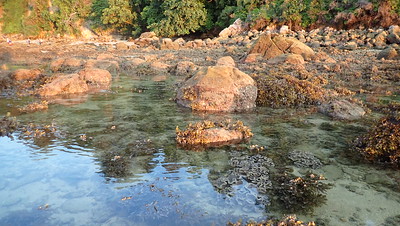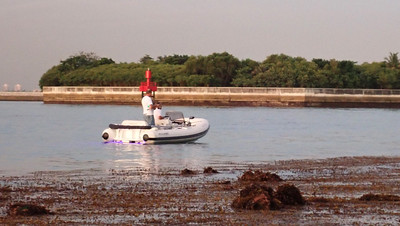A short boat ride from the Central Business District on the main island of
Singapore, are the amazing living shores of St John's Island!
It was a relief to see the hard and soft corals seemed alright, while seagrasses
remain lush. Rare mangrove trees on the untouched western shore were also doing
well. A special treat was to see many little green Knobbly sea stars!
St.
John's Island has some of our more spectacular natural shores. Although most of
its eastern shoreline has been reclaimed or have artificial seawalls, the
northern tip remains untouched. Here's a view of the northern tip of St John's
with the Sisters Islands on the horizon. In fact, the western shore of St John's
Island is part of the Sisters Islands Marine Park!
St John's Island has fascinating rock formations which look stunning in the
clear afternoon sun.
There are not many hard corals on this shore. Today, with the bloom of Sargassum seaweed (normal for this time of the year), it was even more challenging to find
them.
But I saw small colonies of a variety of common corals, most of them in very
good health. I did not see any signs of mass coral bleaching.
There are also some small colonies of Leathery soft corals, they were also
alright.
As on our last survey in Jan 2020, there are many sea anemones on this shore, I didn't see any that were bleaching. Especially on the western shore,
there were many Giant carpet anemones, but no anemonefish. I saw many Frilly anemones, the team saw several Magnificent anemones (one with shrimps) and in the sandy lagoons, many Haddon's carpet anemones one with shrimps. And a first entry for this location, James Koh saw several Swimming anemones.
Among the most interesting finds today were many small green Knobbly sea stars! Vincent Choo also saw an Orange sand star. There was also a big Red feather star. Spider conch snails are quite common
here. I saw the skeleton of the rare Thick-edged sand dollar, but no live ones.
There were also some Common sea stars, and all kinds of other small crabs and
fishes.
The rest of the team saw lots of other interesting marine life too. Like this beautiful Swimming file clam, photographed by James Koh.
While Vincent Choo saw this translucent juvenile flatfish!
I love this shore mainly for the beautiful natural coastal forest that still
grows here. There are not too many of these left in Singapore. The situation
today is quite similar to our last survey in
Jan 2020.
I made the pilgrimage past the tip of the northern shore. To pay my respects to
the grandmother Nyireh laut tree. She is still very much alive! Although there is a large log near her, which
will probably pound into her during the high tide. These trees do live in a
harsh environment.
The two daughter trees next to grandma are still alright.
But one dead tree nearby looks like a Nyireh laut that didn't survive what looks
like a tree fall from the cliffside. There's no sign of recovery.
Today, the Seashore pandan flower was quite low. I had a sniff and it smells like soap! Lots of
little bees were busy gathering at the flowers. Other interesting plants seen
flowering and fruiting were:
Penaga Laut, Chengam, Nyireh bunga,
Tiup-tiup. I even saw a clump of
mangrove fern
growing on the cliff. But I didn't see the Raffles pitcher plant today.
It was great to see many small clumps of
Tape seagrass, most with fresh green and moderately long leaf blades. St John's Island is
one of the few shores left that still has long Tape seagrass.
I saw good growths of
Sickle seagrass
on the western shore facing the Sisters Islands. There were also sprinkles of
Spoons seagrass (with small leaves) in the eastern lagoons.
Today, we didn't come across any fish nets or traps. I saw two men fishing with lines just off the reef from a dinghy. They left as I approached them.
At sunset, a group of about 20 people suddenly turned up on the shore. Not all were masked and they seemed to be mingling freely among one another. I did not notice them coming back to the jetty along the eastern shore. Did they continue northward, make the turn at the northern point and then along the western shore? In the dark, on a new moon? Lots of safety concerns crossed my mind.
Anyway, our small survey team returned by the eastern shore and the last we saw of them was as tiny figures on the horizon as the sun set.
St John's Island in the Singapore Blue Plan
The Singapore Blue Plan 2018 highlights the importance of St John's
Island to our marine biodiversity.
The cluster of Kusu, Lazarus and
St. John's Islands has been recommended by the Singapore Blue Plan 2018 for
elevated protection status. The Blue Plan highlights that Lazarus, St. John’s,
and Kusu Islands are established sites for coral nurseries as their shoreline
offers ideal sheltered areas for growth of corals. Designating these islands as
No-fishing Areas can bolster their rehabilitation.
Protecting a
larger cluster of islands means zonation plans for use can be implemented to
manage tourism and human impacts.
DOWNLOAD the Plan, SUPPORT the
Plan! More on the
Singapore Blue Plan 2018 site.
Photos by others on this trip
Jianlin Liu
Loh Kok Sheng
Vincent Choo
James Koh
Other shores surveyed
Richard Kuah surveyed Coney Island



















